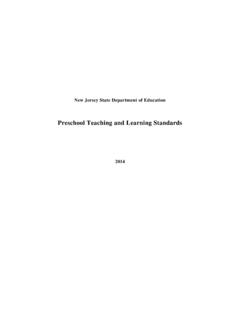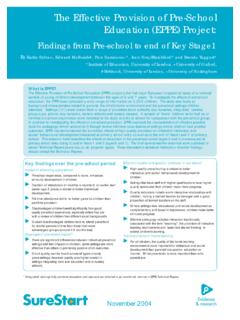Transcription of Play and the Learning Environment - SAGE Publications Inc
1 Play and the Learning Environment10 CHAPTERThis chapter will help you answer these important questions: Why is the physical Environment important for Learning and play? What are some Learning environments? What are the developmental characteristics of play? How do we distinguish play from other behaviors? What are the theories on play? How can teachers use play to help children learn and develop?NAEYC DEVELOPMENTALLY APPROPRIATE PRINCIPLE 10 Play is an important vehicle for developing self-regulation as well as for promoting language, cognition, and social gives children the opportunity to develop physical competence and enjoyment of the outdoors, understand and make sense of their world, interact with others, express and control emotions, develop their symbolic and problem-solving abilities, and practice emergent STANDARD 1: PROMOTING CHILD DEVELOPMENT AND LEARNINGa.
2 Knowing and understanding young children s characteristics and needsb. Knowing and understanding the multiple influences on development and learningc. Using developmental knowledge to create healthy, respectful, supportive, and challenging Learning environmentsKey Elements for Becoming a ProfessionalVignette: Let s Make LunchGabriela, a 4-year-old preschooler, is sitting in a playhouse by a table with a plastic plate, cup, and utensils. She calls out, Do you want to eat lunch? Come on, it s lunchtime! Aviva, also 4, answers, Wait. She wraps up a doll in a cloth and comes in and sits opposite Gabriela. Aviva says, I want to help you make a sandwich.
3 Gabriela says, OK, let s make lunch. In the playhouse, there are plastic slices of bread, ham, tomato, and lettuce. Each child starts preparing her sandwich, and when they finish, the two girls sit and pretend to eat. Aviva then says, I am thirsty; can I have some orange juice? Gabriela says, Yes, let s have some orange juice. Gabriela pretends to pour orange juice into a cup. Aviva then pretends to drink from the cup. Adam, another 4-year-old, approaches and says, I want to play. Gabriela tells him, You have to knock on the door to come in. Adam knocks on the imaginary door, and Gabriela asks, Who is it? Adam answers, It s Adam. Gabriela then pretends to unlock and unbolt the door.
4 Gabriela invites Adam in and asks him, Do you want some orange juice? They all sit down together and pretend to drink orange is very significant for a child during the early childhood years. Therefore, knowledge of the development of different types of play gives educators and parents a foundation for proper teaching strategies. Goodman (1994) reported that the preeminent teaching for young children happens at the midpoint of a continuum between play and work. Professional early childhood teachers who are aware of and comprehend developmental theories of play are better prepared to use play as a context for instruction and assessment. They also understand the importance of play in social, emotional, cognitive, physical, and motor domains of development.
5 Therefore, it is extremely important that teachers of young children have a strong academic background in the study of play to best evaluate problems and offer appropriate support to children who have a hard time playing, such as children with physical vignette presented at the beginning of this chapter is an exam-ple of play, and most observers would describe it as cooperative play, when a group of children play and interact socially together. Play is an important element of a child s life. It helps children achieve mastery in certain skills, and they learn to have control over their Environment . The Environment and play are important elements that support each other.
6 Even though the concept of play seems very simple, in reality the study of play is quite complex, as you will learn in reading this chapter. This chapter first discusses the definition of the physical Environment and play, the defining characteristics of play, and the leading theorists. It goes on to examine the importance of play and the significance of play in children s PART IV Implementing the Early Childhood CurriculumWHY IS THE PHYSICAL Environment IMPORTANT FOR Learning AND PLAY?A well-arranged Environment should enhance children s development through Learning and play. It facilitates classroom management and supports the implementation of curricular goals and objectives (Catron & Allen, 2007).
7 The way the physical Environment is designed and configured influences how children feel, act, and behave. The physical Environment allows growth and development through activities and materials in defined play areas. Room arrangement for play activity plays an important role in students social and language interactions. Poorly designed classrooms can cause disruptions and negative social interactions among students and/or between students and the teacher. For example, having the reading and writing center next to the music area would cause disruptions among children who are trying to concentrate on the skill of writing. Students can become frustrated when they do not have an organized Environment to call their own (Clayton & Forton, 2001).
8 The physical Environment is a direct image of the teacher s planning and the student s Learning . It is where both teachers and students will spend most of their time and a place they can call their own and relate to. It should be well organized, comfortable, and personable and offer a variety of manipulates for cognitive, social, emotional, and physical development (Catron & Allen, 2007).Definition of the EnvironmentTo understand play, we first must understand the importance of the Environment in the eyes of children and adults. Some people may see the Environment as insignificant, but for teachers, parents, and educators it is something that needs to be considered a high priority.
9 Environment is defined as the physical Environment , its surroundings, and a specific setting (Vickerius & Sandberg, 2006).The physical Environment will vary depending on the age and number of children in the classroom, as well as the goals of programs and specific activities in the classroom. The infant classroom, for example, will designate the eating, sleeping, diapering, and play areas as primary for activities. However, the most important space in which activities will be performed is the play area. The play area of infants needs to be configured so that they can grasp and reach age-appropriate toys or pull themselves up when practicing standing or walking (Vance & Boals, 1989).
10 Infants will need to be down on the floor exploring their environments with toys to look at, listening to things around them, feeling, chewing, pushing, pulling, stacking, rolling, turning, squeezing, and shaking (Vance & Boals, 1989). To maximize infant supervision, it is best to have all the activities in one room. This includes the sleeping area. Some researchers have recommended a separate room for sleeping (Willis & Ricciuti, 1974); others, however, have found that sleep patterns are not adversely affected by having a sleeping area in the same room as a play area (Twardosz, Cataldo, & Risley, 1974). Having a cozy, warm, and homelike Environment in the classroom provides infants with a healthy social/emotional physical Environment for a toddler classroom has eating, napping, diapering, toileting, and playing areas.













